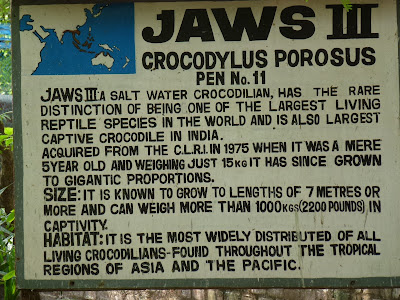Now, where was I?

Sometimes, conservation efforts get a lot wrong. The Irula Snake-Catchers Industrial Cooperative Society is an example of getting a heck of a lot right. Conserving land and animals often means displacing people or taking away their livelihood. Below is an excerpt from the Madras Crocodile Bank's website about the Irula snake catchers (http://www.madrascrocodilebank.org/cms/conservation-and-research-2/the-irulas/):
"The Irula Snake-Catchers Industrial Cooperative Society (ISCICS)
The Irulas are the pre Dravidian inhabitants of the scrub jungles of
Southern India. Hunter-gatherers by tradition, their expertise in
catching snakes is legendary. Prior to the Indian Wildlife Protection
Act of 1972, the Irulas were one of the leading suppliers of snake skins
to the global exotic skin industry. So successful were they that the
hunting of snakes for their skins was eventually banned in 1972 to
prevent the local extinction of several species. This deprived them of
their main source of livelihood and initially the outlook for these
skilled hunters was bleak.
In 1978 the Irulas, along with Romulus Whitaker and Revathy Mukherji,
sought the help of the Department of Industries and Commerce to start a
self employment scheme using their traditional knowledge. Thus was born
the Irulas Snake-Catchers Industrial Cooperative Society which was
officially registered on 19 December 1978.
The main objectives of this co-operative were to harness the
traditional skills of the Irulas positively, accord a dignity to their
indigenous knowledge and to provide them with a means of social and
economic upliftment. In time a specialist snake handling facility was
constructed at the Croc Bank to maintain snakes for venom extraction and
to market the venom to various laboratories around India. In addition,
their traditional skills together with their knowledge of indigenous
wildlife were promoted as valuable resources for naturalists and
government agencies involved in wildlife work. More recently they have
become a popular tourist attraction at the Croc Bank, demonstrating
their skills of snake-catching and milking to visitors.
The ISCICS focuses its efforts on the four common species of venomous
snakes that account for the majority of snakebite related deaths in
India. The Big Four include the Indian cobra,
Naja naja, Russells viper
, Daboia russelli, common krait,
Bungarus caeruleus and saw scaled viper,
Echis carinatus.
The required species and number of individuals needed are decided by a
committee and members are informed on a monthly basis. The licensed
members then go out and catch the snakes which are then sold to the
society at an agreed fixed rate. Once purchased, the snakes are kept in
individual earthen pots in a snake pit. The length, weight, sex and site
of capture are recorded at the time of purchase. Each snake is marked
with a unique code clipped into its ventral scales. Venom is extracted
from each snake once a week for four weeks. Snakes are then released at
predetermined sites in Reserve Forests nearby, in the presence of a
Forest Ranger.
Venom, once collected, is freeze dried and stored at 10º C in the
freeze chamber of a Lyophilizer. This turns it into minute crystals. The
crystallized venom is gathered in airtight bottles and stored in a
refrigerator. The society sells the venom to a number of laboratories
for preparation of antivenin and for medical research."
----
Milking demonstrations are performed under a thatched roof. The pavilion's sandy floor is about four feet below ground level, and has concrete walls. Visitors stand at the concrete wall (a little less than waist-high) and look down into the pavilion to observe the demonstration.
Collected snakes are stored in large clay pots that are secured with cloth lids. Records of capture date, sex and weight of the animal are kept simply by writing on the clay pots with chalk.
This was hanging from the pedestal where they milked the snakes.
I loved how these two cobras were kind enough to pose so we could compare their dorsal and ventral scales.
The two snake handlers who were giving the milking demonstration.
Cobra milking.
Common krait
Russell's Viper
Saw-scaled Viper
Outside the Crocodile bank, a few venders sell coconut and fresh fruit. Kieran is in yellow, Lakhdeep in blue, and Milan in red.
A cow finds a meal in the fruit stand trash.
A sleeping baby. Many of the babies here are adorned with bracelets and anklets.
----
We decided to stop once more in Mamallapuram for lunch before heading south towards Pondicherry. Those Babra boys love their calamari, and the idea of eating another meal of fresh caught fish was too enticing to pass up.
Lakhdeep walked over to the yoga studio across the street to take our photo.
Left to right: Kieran, Isabelle, Annie, Alexis, Henrietta and Milan
Next stop? DUNE























































